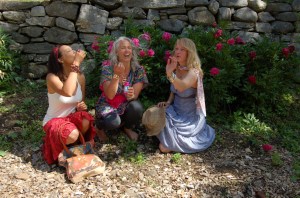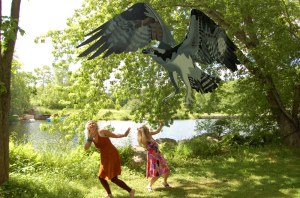Today the Mexicali creative crew and three lovely models took a field trip to Damariscotta Mills, home of Maine’s oldest and most productive alewife fishery. We had a great time, took some wonderful pictures, and were lucky to encounter friendly people who graciously allowed us to traipse across their property for our picture-taking. Everybody had a good time and we were all happy that the sun was shining! Here are some of the things that we did:
 playing ukulele on the fish ladder
playing ukulele on the fish ladder
 being terribly serious at all times
being terribly serious at all times
 meeting Moxie, the adorable pup
meeting Moxie, the adorable pup
“Why are they looking at married women drinking hoppy beer in the water?” you might be asking. For those of us just coming into the know, alewives are a type of fish! They spend the majority of their lives at sea, but come to freshwater to spawn. Using their sense of smell to guide them, the alewives migrate upstream from the ocean to calmer waters in rivers, streams, ponds and lakes. The fish ladder is a stone-built structure that allows the alewives to swim all the way upstream even though there is a dam at the top of the river.
 Look closely and you will see many alewives swimming upstream!
Look closely and you will see many alewives swimming upstream!
The alewives undertake their long journey to spawn every year in May and June. The Fish Committee of Nobleboro and Newcastle puts on a festival annually during Memorial Day weekend to celebrate the “running of the alewives”. Everybody gathers to marvel at the mass migration of the fish, and there are activities, music, food, and fun! All of it is to benefit the restoration of the fish ladder, which has been deteriorating steadily over the years in ways that quick fixes can’t salvage. Learn more about their restoration efforts and how you can help here, and check out the Damariscotta Mills Fish Ladder Restoration Project here to learn more about the mills, alewives, and where to go if you want to go see them swimming upstream!
Thanks to our three wonderful models and the folks who let us legally trespass for a good photo! All clothing, jewelry, and accessories in these photos can be found in Mexicali Blues stores, with some items also available at MexicaliBlues.com.
The post Alewives & the Damariscotta Mills appeared first on Mexicali Blues Blog.







